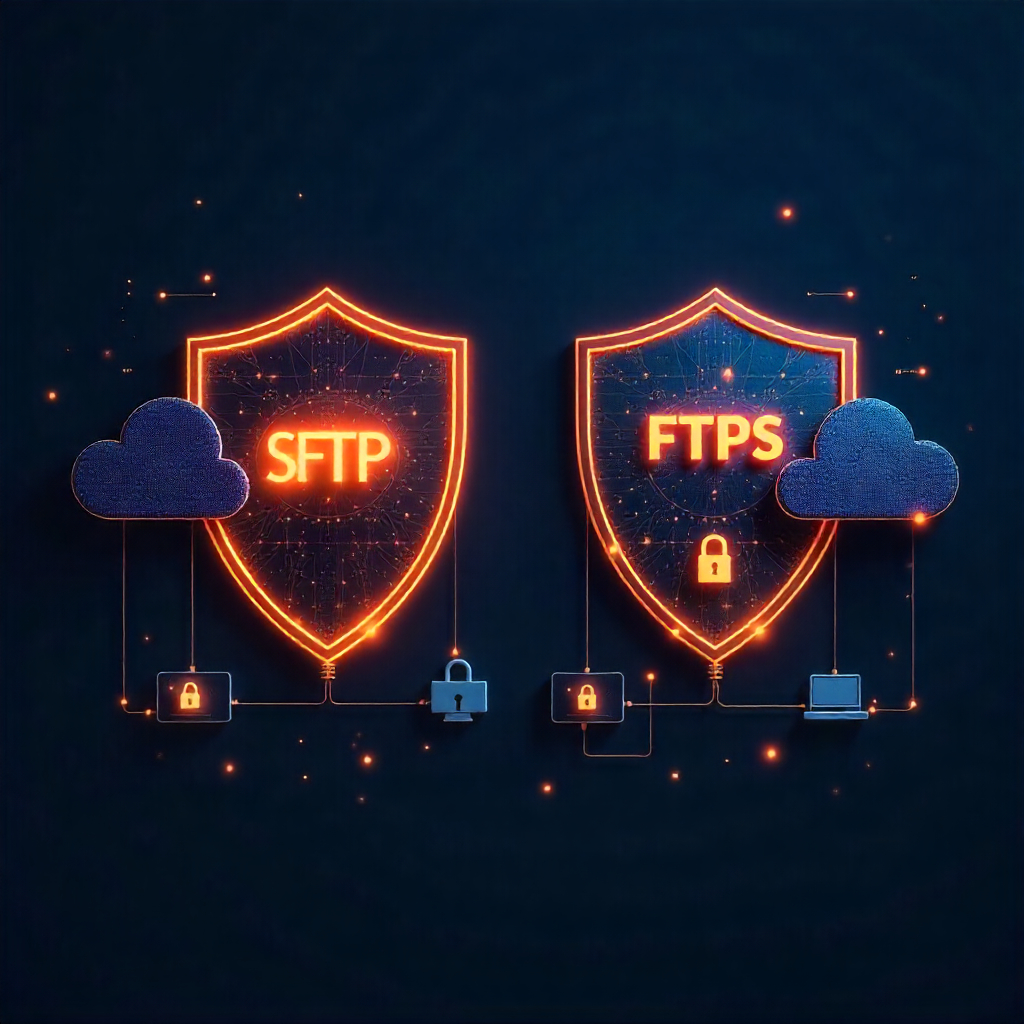MFT Gateway is a hosted Software as a Service (SaaS) solution that enables file exchange over the AS2 or SFTP protocol, without the need to install or maintain.
- Blog
- Streamline Your File Transfers: The Importance of SFTP Automation
SFTP
Streamline Your File Transfers: The Importance of SFTP Automation
Learn how SFTP automation boosts security, reduces errors, and enhances efficiency in file transfers for sensitive data. Read our blog!.

Sampavi Sriparan
Published: 07 Nov 2024

Automate message exchange over SFTP
SFTP, or Secure File Transfer Protocol, refers to a protocol aimed at ensuring the safety of transferred files using a reliable stream of data. It utilizes the SSH (Secure Shell) protocol to create encrypted channels for both authentication and file data transmission over the network. This feature makes SFTP the recommended option for firms and institutions that need to share and exchange sensitive information securely.
The need for automation in SFTP
When it comes to manual file transfer over SFTP, the process involves several stages: connecting to the server, selecting the specific files, uploading and downloading them from the server, and then disconnecting from it. Although this procedure is quite basic, it can become tiresome, difficult, and unproductive for especially large files or for numerous such transfers. Automation simplifies and enhances the entire operation, minimizing human involvement and ensuring faster, safer, and more scalable processes.
1. Challenges of Manual SFTP Processes
- Time-consuming process
Any file transfer entails a number of processes, such as connection establishment, directory navigation, file selection, and uploading or downloading, often performed manually. Large files are more difficult to transfer; they can take an arduous amount of time.
- Risk of human error
The manual selection could lead to mistakes such as the upload or download of wrong documents, which may have severe business impact. When users navigate through numerous files and folders, they risk getting lost, increasing the chances of sending files to the wrong location or accidentally overwriting other files.
- Complexity
Human intervention cannot effectively schedule file transfers between an application and a user such as during off-peak hours or predetermined times, which may create operational inconveniences, especially when transfers are required outside normal working hours. Users must manually handle tasks like file compression, transfer logging, and sending alerts for successful or failed transfers, as these processes cannot be automated, making the workflow less efficient.
- Monitoring and logging difficulties
Maintaining the status of each transfer in a manual SFTP process, especially when large file transfers are involved, can be challenging. Therefore, users often have to check the status manually or rely on simple error messages. The problem with manual transfers is that there is no proper mechanism to report each transaction, making it difficult to investigate issues such as transfer failures, missing files, or unexpected delays.
- Dependency on human availability
Companies that utilize manual file transfers have to depend on the presence of staff, which is not always guaranteed. Any absence or unavailability can disrupt business operations. When files need to be transferred within unpredictable timeframes, such as during red alert situations, relying on manual processes can be counterproductive, as the slow human response may delay the transfer of critical files.
- Manual recovery from failures
In the case where a file transfer was unsuccessful, users must troubleshoot the problem themselves. In high-volume situations, identifying the reasons for the failures may be time-consuming and may cause delays in resolving critical defects. As a result, the entire process may need to be restarted, leading to prolonged delays and even more serious issues like duplicate delivery.
2. Benefits of SFTP automation
Increased utilization of SFTP automation in file transfer processes greatly boosts the efficiency, security, reliability, and scalability. It reduces the need for human intervention, thereby saving time and providing businesses with tools to manage large volumes of data safely and in accordance with regulations. This makes SFTP automation a necessity for today’s businesses, which have sophisticated needs for transferring files and related communications.
- Time-saving
Automation simplifies and makes the entire file exchange process efficient, thus there are no manual efforts such as connecting to servers, searching for files, and launching a file transfer. Automation allows transfers to be planned and executed at any time, including outside of working hours, ensuring continuous operation.
- Error reduction
Every file transfer is carried out satisfactorily every time, according to a predefined set of instructions, eliminating the chances of human errors like wrong file selection or skipping of transferring important files. Automation removes typical mistakes that are common to all manual processes, for example, lost files, partially completed uploads, and accidental file replacement.
- Scheduled and Timed transfers
Transfers can be scheduled at fixed times without requiring any human involvement, so the files are always transferred when needed. It is also efficient to schedule file transfers to take place at off-peak times to reduce congestion on the network and make better use of resources without interfering with day-to-day business activities.
- Scalability
Automated systems can perform large numbers of file transfers concurrently without any delay in performance, making it easier to scale operations as file volumes increase. Automation is especially important for handling Very Large Files (VLFs) since manual processes are more prone to failures or delays.
- Enhanced security
The use of automated systems ensures that all encryption protocols (for instance, SSH encryption) are adhered to, in order to maintain the confidentiality and integrity of the files being transmitted. Automating the system ensures that optimal security measures are consistently applied, eliminating risks such as misplaced credentials, unauthorized access, or the loss of data.
- Monitoring, reporting, and alerts
Real-time tracking of each transfer enables prompt detection of any breakdowns or interruptions. Automated systems keep a comprehensive history of each transfer, documenting the time, the files involved, and any issues that were encountered. In the event of a transfer failure, automated systems can immediately alert relevant personnel.
- Cost-efficiency
Through the use of automation processes to perform repetitive manual tasks, companies can minimize the number of personnel required to oversee or manage file transfers, thus reducing the cost of labor and eliminating instances of errors or avoidable delays in manual file transfers.
Implementing SFTP Automation
SFTP supports automation techniques for file transfers that ensure they are conducted regularly and securely without the involvement of personnel. The process involves selecting appropriate tools and a scripting language, then setting the environment, writing scripts, debugging them, and scheduling the scripts to run afterwards. Below is a comprehensive procedure for executing SFTP automation.
1. Choosing key tools and scripting language
The first requirement for SFTP automation is to identify the appropriate tools and scripting languages that suit your environment.
Key tools
There are a number of different third-party tools that help in implementing SFTP transfers by, for example, encrypting files for a safer transfer, scheduling their transfer, and even logging their transfer
- WinSCP - A popular open-source SFTP client for Windows operating systems. Comes with a friendly graphical user interface and facilitates SFTP, SCP, and other protocols.
-
Cyberduck - A cross-platform open-source file transfer client that supports SFTP with a heavy focus on security and encryption.
-
FileZilla - An FTP, FTPS, and SFTP client available on all platforms with provisions for transfer either manually or by scheduling.
Scripting languages
The programming languages listed below are largely utilized in writing SFTP automation procedures.
-
Bash - Best for Unix-based operating systems, giving freedom to perform basic actions while writing a script.
-
Python - An easy programming language with a variety of scripting functionalities, and especially useful for the SFTP function thanks to modules like paramiko.
-
Java - Supports integration into business software with enhanced complexity, which is typically required for the majority of the automations.
2. Configuring automation tools and scripting environment
After choosing the preferred software and scripting language, the next step is to install and configure the SFTP automation tools and also configure the scripting environment.
You need the following key configuration parameters
- Hostname - The address or IP of your SFTP server.
- Port Number - The default port for transferring files using SFTP is 22.
- Authentication - The authentication can either be via username and password, or by using an SSH key.
- Source and Destination Directories - Specify the local path for the originating files and the external target location for the files being moved.
- Encryption Settings - Make sure the transfer is secure because it is crucial that the data sent during file transfer remains secured from intruders.
3. Writing the automation script
Following the setup of the environment, the subsequent phase entails the development of the automation script.
The script should comprise instructions that will address
- Establishing a connection to the SFTP server through given hostname, port, and login details
- Picking files from the local directory
- Transferring files to the remote server
- Documenting the audit for transfers completed along with the status of each
4. Testing the script
Prior to ordering a schedule, test the script in a non-production environment with sample data. It is essential to confirm that all features, such as file transferring, logging, and error handling, are functioning as expected.
5. Scheduling the script for regular execution
After testing the script and confirming it works properly, you can set it up to run automatically at regular intervals as applicable.
6. Monitoring and maintaining the automation
Once you implement SFTP automation, conducting regular system checks becomes essential to ensure that the file transfers occur as expected. Provide for the use of automated alerts/logs for any errors that may arise, such as transfers that fail or authentication issues.
In addition, always ensure your automation scripts are current with the following, especially
- Changes in the source or destination directories
- Modifications in authentication credentials or security policies
- Updates to encryption protocol
Addressing common challenges in SFTP automation
In order to reduce the risks associated with SFTP automation, it is important to include some form of error handling in the scripts to deal with events such as incomplete transfers, network outages, or authentication errors. Adequate tracking and logging systems will allow for the recording of transfer status and early detection of any potential issues. Employ safe methods of authentication such as SSH keys, and use encrypted channels for file transfers to protect the confidentiality and integrity of information. Frequently revise the automation scripts and tools to keep pace with changes in file directories, credentials, or security policies. In addition, carry out regular tests to avoid unforeseen breakdowns and ensure the consistent, high-quality transfer of files.
Conclusion
To conclude, automating message exchange over SFTP is effective, secure, and efficient. Automation of processes enables organizations to guarantee continuous and accurate transfers of files without relying on human intervention. The exchange of messages over SFTP promotes efficiency in the organization’s operations, protects data from potential breaches, and minimizes human errors.
Our MFT Gateway solution offers SFTP-based message exchange with built-in features to handle file transfers effortlessly. MFTG allows users to automate complex operations such as schedule creation, issue management, and alerting, without requiring manual involvement. Users can utilize their own automation scripts to expedite the process of exchanging communications via SFTP.

Talk to an EDI Expert
Join hundreds of organizations already taking full control of their B2B AS2 communications with our trusted solutions. Contact us today to tailor a solution that fits your specific AS2 EDI needs.
Related Articles
View All BlogsExplore our product stack
Try before you buy with a 30-day Free Trial
No commitment, all value. Try the AS2 Solution Risk-Free and discover how our solutions can transform your business workflows. No credit card required.
Explore Your Possibilities
Elevate AS2 Communications with our EDI and AS2 Solutions
See how our AS2 and EDI solutions can simplify your integrations, boost efficiency, and keep you compliant—request a personalized demo today.













































































































































































































